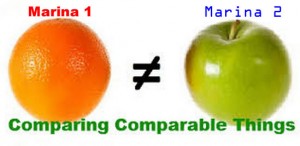Selling the Sales in an Up Market
When the market is lukewarm or hot (remember those days?), your appraiser will have enough sales data to work with. Or at least, he/she should. You’ll see three, four, five, or more sales in the report. Even though the appraiser considers them “comparable” sales, in most cases, they really aren’t. ‘Sorry to be the bearer of bad news.
Market Tiers
 Granted that virtually no two marinas are alike, this isn’t an excuse for data that isn’t comparable. The biggest problem is with market tiers. If your marina is a plain marina (i.e. a “warehousing” marina), that’s a very different market from the boat dealership marina or the boat yard marina. If your marina is 100 slips, that’s a different market from the 300 or 400 slip marina because the sale price difference will attract different buyers between the two. If your marina is in Downtown Annapolis, that’s a different market than the Eastern Shore or Northern Anne Arundel County (the same thing applies to Boston Harbor versus the outlying, mostly suburban areas and many other cities). If you’re a yacht marina, you’re in a different market from the cruiser marina. I’ve yet to meet a marina owner who would consider a 100 slip and a 40o slip marina substitutes. If your marina is a lake marina, it’s probably not comparable to a blue water marina, so mix and match doesn’t work. I could continue, but I’m sure you get the point.
Granted that virtually no two marinas are alike, this isn’t an excuse for data that isn’t comparable. The biggest problem is with market tiers. If your marina is a plain marina (i.e. a “warehousing” marina), that’s a very different market from the boat dealership marina or the boat yard marina. If your marina is 100 slips, that’s a different market from the 300 or 400 slip marina because the sale price difference will attract different buyers between the two. If your marina is in Downtown Annapolis, that’s a different market than the Eastern Shore or Northern Anne Arundel County (the same thing applies to Boston Harbor versus the outlying, mostly suburban areas and many other cities). If you’re a yacht marina, you’re in a different market from the cruiser marina. I’ve yet to meet a marina owner who would consider a 100 slip and a 40o slip marina substitutes. If your marina is a lake marina, it’s probably not comparable to a blue water marina, so mix and match doesn’t work. I could continue, but I’m sure you get the point.
Have you figured out the common theme here? To have a reliable sales comparison approach, the sales have to be comparable (it’s called the sales “comparison” approach for a reason). Comparability shouldn’t be determined by the appraiser but by the market, or shall I say market participants. As part of the verification process, I’ve had many an occasion to ask a simple question of the buyer that determines comparability. If, say, my subject were 100 slips and I was verifying a sale of a marina with 300 slips, all I have to add to the conversation is a simple question: “Did you or would you have considered a 100 slip marina?” That’s all it takes. Nine times out of ten, the answer is “no” and in most cases, I even get an explanation why not. It then becomes easy to say I considered other sales like this one but the owners did not consider them substitutable with the subject, so they aren’t comparable (hence their exclusion from the sales comparison approach). Simple… clean… but it does take time and effort to get this information.
Other Sales Comparison Clues
Other clues include the number and amount of the adjustments as well as whether there is anything in the sales write-up that indicates it’s verified. Let me just go on the record to say that there are a lot of sales that are not arm’s-length in the marina business and if the data isn’t verified, it’s a lead, not a sale. Sales that have a line item that says “Verified With” and then “buyer”, “seller”, etc. and no further information that indicates the appraiser actually spoke to someone at the marina are probably not truly verified.
Let me give you an example. A marina sale that has 15 acres of land but a very low building density probably has wetlands, poor soils, flood plane issues, etc. If the sale says verified with the seller and there’s no discussion of the excess land, either the appraiser isn’t asking the right questions or he/she hasn’t really verified it. This sort of information an appraiser needs to know to get the adjustment right. Another example is the appraiser says the site has approvals for additional slips or buildings but doesn’t mention them. Wouldn’t you expect the appraiser to ask that question as part of the verification? That’s the kind of thing you need to help make an excess land adjustments. A final example is a verified sale that has no financial information (i.e. cap rate or gross income multiplier) and no mention of whether this disclosure was refused or eve that the appraiser asked the question.
In Part 5, I’ll explore using the Cost Approach in lieu of the Sales Comparison Approach and why any reliance on it will result in a bad appraisal.

